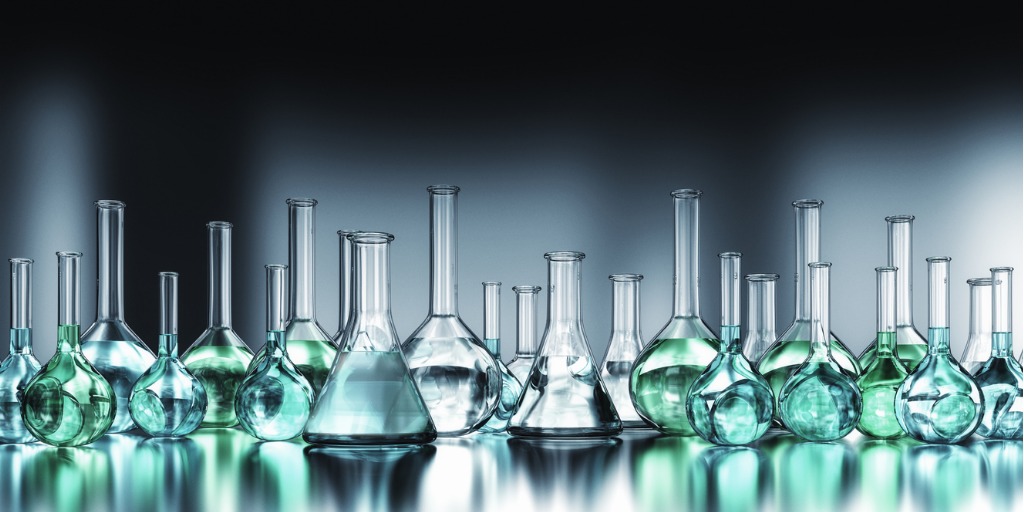
Glass modifiers such as lithium oxide, calcium oxide, and zinc oxide can be used to fine-tune the properties of silicate and borate glass to suit a number of niche engineering applications. In this article we take a look at the ways in which common glass modifiers are used to create high-specification glasses for various applications.
Ordinary glass is a unique material. It’s heat-resistant, exhibiting low thermal expansion and excellent thermal shock resistance; chemically durable; exhibits high electrical resistivity; and of course, is highly optically transparent. These properties have made glass an indispensable material in architecture, labware, electronics, and engineering.
Glass can be further transformed into a true wonder-material through the use of glass modifiers. Just like other materials such as steel, the properties of glass can be precisely tuned and augmented through the careful addition of chemical modifiers to suit a huge array of demanding applications.
Glass structure and composition
The constituents of glass can be broadly divided into three categories: network formers, modifiers, and intermediates.1 Network formers form a highly cross-linked network of chemical bonds and constitute the bulk of the glass. Silicon oxide is the most common network-forming constituent of glass, but glasses based on other oxides such as boron and germanium are also commonly produced.
Modifiers are chemicals that can be added to glass in small quantities to further alter the properties of a glass. These include lithium, sodium, potassium, and calcium; which exist as charged single atoms (ions) amongst the cross-linked network formers, reducing the relative number of strong bonds in the glass and lowering the melting point and viscosity.
Intermediates; which include titanium, aluminum, and zinc; are chemicals that can behave as network-formers or modifiers depending on the glass composition.2 Glasses are naturally highly disordered, and require a carefully tuned balance of network formers, intermediates, and modifiers to prevent the formation of ordered crystallites within the material.
Effects of glass modifiers
As glass generally acts like a solution, the properties of modified glass can be approximately described by additivity relationships: that is, each ingredient contributes to the bulk properties of the glass by an amount roughly proportional to its concentration.3
Glass modifiers interrupt the normal bonding between glass-forming elements and oxygen by loosely bonding with the oxygen atoms. This creates “non-bridging oxygens,” and lowers the relative amount of strong bonding within the glass. As a result, glass modifiers generally have significant effects on glass properties.
These include a reduction in melting point, surface tension, and viscosity due to weaker overall bonding within the material. These are some of the primary reasons for using glass modifiers – they make glass easier to work with at lower temperatures without affecting transparency.4 Glass modifiers affect the coefficient of thermal expansion, chemical durability, and the refractive index.
Glass modifiers for high-specification applications
Despite a number of common properties, the unique chemical properties of different glass modifiers can have varying effects on the properties of the glass produced.
Chemical Durability
The use of alkali metals such as sodium and potassium as modifiers generally reduce the chemical durability of glass, whereas alkaline earth metals such as calcium can increase the chemical durability of glass.5
Resistivity
In electronics, the high resistivity and permittivity of glass lend it to applications in resistors and capacitors. The addition of tellurium, germanium or titanium oxides to glasses in low concentrations have been shown to drastically increase resistivity, making them popular as glass modifiers for ultra-high resistance applications such as hearing aids and infrared detectors.6
Glass for labware
Glass with strong chemical durability and resistance to thermal shock is highly valued in labware manufacturing. The addition of zinc oxide to silicate glass can reduce thermal expansion effects, making it especially resistant to thermal shock. Borosilicate glasses, which use borate as well as silicate as a network former, are also especially thermally resistant and chemically durable, making them a popular choice of material for reaction vessels, test tubes, and other labware.
Specialty optical properties
Some glasses are prized for unusual optical characteristics: zinc-modified glass is widely used in photochromic lenses, while silver, gold, and copper can produce photosensitive glass which changes color in response to incident light.4,7
Bioactive glass
Of particular interest to the biomedical community, bioactive glass is a form of modified glass that closely emulates the properties of the mineral portion of living bone. Bioactive glass is highly biocompatible and forms strong chemical bonds with bone.
This material consists of around 45% silicate with calcium and sodium acting as the primary modifiers. This results in a comparatively soft glass which can be readily machined into implants for use in the repair of bone injuries.8
Mo-Sci leading precision glass technology
Mo-Sci is a world-leader in precision glass technology and produces a range of high-specification glasses for application in healthcare, electronics, and engineering. With expertise including bioactive glass, high refractive index glass, and fluorescent glass; Mo-Sci is able to produce custom solutions for virtually any glass application. Contact us today with your specifications!
References
- Karmakar, B., Rademann, K. & Stepanov, A. L. Glass nanocomposites: synthesis, properties, and applications.
- Kienzler, B. Radionuclide source term for HLW glass, spent nuclear fuel, and compacted hulls and end pieces (CSD-C waste). (KIT Scientific Publishing, 2012).
- Industrial glass | Britannica.com. Available at: https://www.britannica.com/topic/glass-properties-composition-and-industrial-production-234890#ref608298. (Accessed: 17th May 2019)
- Phillips, G. C. A Concise Introduction to Ceramics. (Springer Netherlands, 1991). doi:10.1007/978-94-011-6973-8
- Hu, J. MIT 3.071 Amorphous Materials 2: Classes of Amorphous Materials. https://ocw.mit.edu/courses/materials-science-and-engineering/3-071-amorphous-materials-fall-2015/lecture-notes/MIT3_071F15_Lecture2.pdf
- Weißmann, R. & Chong, W. Glasses for High-Resistivity Thick-Film Resistors. Adv. Eng. Mater. 2, 359–362 (2000).
- Photosensitive glass. (1948). https://patents.google.com/patent/US2515275
- Rahaman, M. N. et al. Bioactive glass in tissue engineering. Acta Biomater. 7, 2355–2373 (2011).

